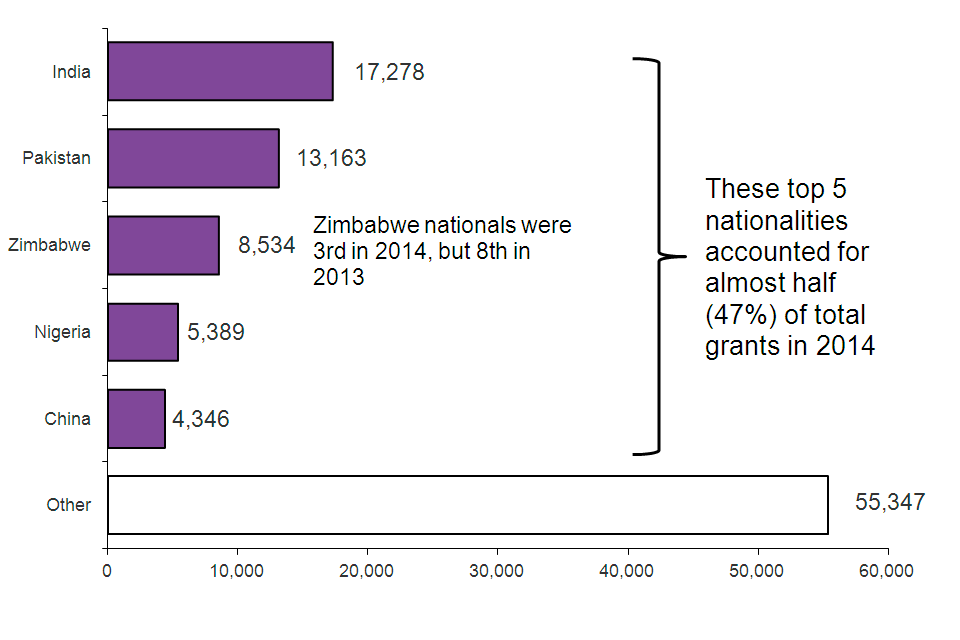Settlement
Published 26 November 2015
Valid: 26 November 2015 to 24 February 2016
Data relate to the year ending September 2015 and all comparisons are with the year ending September 2014, unless indicated otherwise.
Back to ‘Immigration statistics July to September 2015’ content page.
This is not the latest release. View latest release.
1. Key facts
The number of people granted permission to stay permanently fell by 12% to 98,506 in the year ending September 2015. The number of grants is low relative to the peak number of grants in the year ending September 2010 (241,586), and similar to levels seen in 1999 (97,117). The decrease was largely accounted for by falls in family-related grants (-15,645).
Work-related grants to stay permanently fell by 3% to 41,289 in the year ending September 2015, continuing earlier falls from 92,176 in the year ending June 2010. Settlement granted after 5 years with a work permit decreased from 5,027 to 560, reflecting the replacement of the work permit scheme by the Points-Based System. Grants to Tier 1 High Value individuals fell from 21,866 to 19,857 whilst grants in the Tier 2 Skilled Work category rose from 10,248 to 16,879.
There were 22,311 family-related grants to stay permanently in the year ending September 2015, 41% lower than the previous 12 months. There were notable decreases in grants to wives (from 21,382 to 12,739), husbands (from 10,759 to 6,473) and children (from 5,116 to 2,849). This may partly reflect changes to the rules in July 2012 on how quickly partners qualify for settlement and the number of visas and extensions granted in previous years. Details of the July 2012 rule changes are included in the Family section of the user guide.
Asylum-related grants to stay permanently rose 11% to 19,032 in the year ending September 2015 but this is significantly lower than the peak in 2005 (67,810).
These year-on-year comparisons of decisions numbers can be affected by changes in case work resource allocation. Such fluctuations can be examined in more detail in the quarterly data that are also available in the published tables.
2. Grants to stay permanently by reason, and refusals
| Year | Total decisions | Total grants | Work | Asylum | Family | Other (1) | Refusals | |
|---|---|---|---|---|---|---|---|---|
| Year ending September 2011 | 191,915 | 182,892 | 68,973 | 11,385 | 55,407 | 47,127 | 9,023 | |
| Year ending September 2012 | 138,749 | 134,532 | 65,303 | 11,958 | 46,826 | 10,445 | 4,217 | |
| Year ending September 2013 | 160,030 | 153,654 | 60,687 | 21,393 | 59,277 | 12,297 | 6,376 | |
| Year ending September 2014 | 118,293 | 112,391 | 42,364 | 17,199 | 37,956 | 14,872 | 5,902 | |
| Year ending September 2015 | 103,211 | 98,506 | 41,289 | 19,032 | 22,311 | 15,874 | 4,705 | |
| Change: latest 12 months | -15,082 | -13,885 | -1,075 | +1,833 | -15,645 | +1,002 | -1,197 | |
| Percentage change | -13% | -12% | -3% | +11% | -41% | +7% | -20% |
Table notes
Source: Home Office, Immigration Statistics July to September 2015, Settlement table se 02 q.
(1) The high number of grants in 2011 mainly resulted from a review of the backlog of cases from before March 2007 involving unsuccessful asylum applicants.
3. Long-term trends in grants to stay permanently
The chart below illustrates longer-term trends in grants to stay permanently for the calendar years back to 2004.

Chart notes
Source: Home Office, Immigration Statistics July to September 2015, Settlement table se 02.
4. Nationalities granted permission to stay permanently
Of the total 104,057 grants of permission to stay permanently in 2014, over a third (37% or 38,820) were to nationals of South Asia and over a quarter (27% or 28,240) were to nationals of Sub-Saharan Africa.
Top 5 nationalities granted permission to stay permanently, 2014
(Total 104,057)

Chart notes
Source: Home Office, Immigration Statistics July to September 2015, Settlement table se 03.
5. Data tables
Further data are available in Settlement tables se 01 to se 06.
6. Background information
The figures in this section relate to the number of people, subject to immigration control, who are granted or refused permission to stay permanently in the UK, known as settlement.
The numbers of applications and decisions about permission to stay permanently reflect changes over time in levels of those entering the country, as well as policy and legislative changes. These may affect the number of people potentially eligible to stay permanently. The availability and allocation of resources within the Home Office can also affect the number of decisions.
